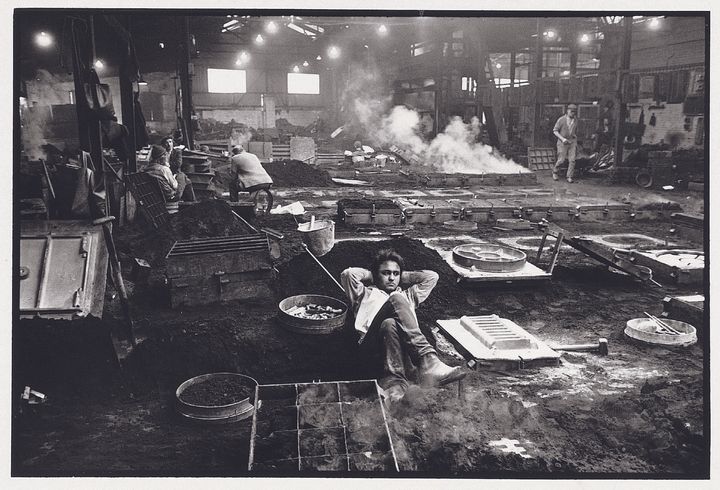
FOUNDRY WORKER, BIRMINGHAM (1972) PAUL HILL
Why Heritage?
The Heritage Lottery Fund since it’s inception in 1994 has distributed over £7.1 billion to projects across the UK, helping people to enjoy and protect their heritage. Up and down the country there are a number of organisations running events and researching South Asian history in Britain, many in light of the 70th anniversary of India’s independence from British rule. Since March this year I have been working with the Library of Birmingham on a unique exhibition that is HLF funded, and explores 400 years of history between Britain and South Asia, namely India, Pakistan and Bangladesh. This is exciting for me and for Birmingham. Most of us that are of South Asian origin, through childhood, conversations with family members and our own research, know pieces of our history and heritage of the last century. This Exhibition entitled ‘Connecting Stories: Our British Asian Heritage’ is an opportunity to go much further back and explore how these two continents started to interact.
Decolonizing Education
More importantly, it is an opportunity for people of all backgrounds to learn more about Britain’s complex history, as this is something we are not taught fully during our school years. History is a complicated topic in itself regarding how history is told, what is shared and by whom. There are movements challenging the status quo. Decolonizing education is an ongoing debate at the moment that argues that education in the West is Eurocentric exploring stories about dead white men who oppressed a lot of the world. One sided perspectives are not helpful and influence how citizens of a country see themselves, their identity, nationhood, and can contribute to the development or dissolvement of racist and xenophobic ideologies. Arts and cultural activities in the performing and visual arts, in museums and libraries also act as education devices. Cultural venues can be spaces for debate, discussion, experimentation and interrogation of ideas and challenges existing in society.
The Exhibition and Engagement
The nature of Connecting Stories encourages more questioning, more storytelling, and engagement with the artefacts on display. There are a number of posters, maps, photographs and objects with descriptions dating back 100s of years from two collections. They tell stories about a range of themes including trade, business, food, freedom and justice, culture, migration and more, in exploring the relationship between Britain and South Asia to present day. Many items belong to the Library of Birmingham archives, and there are many local stories shares about Birmingham and the Black Country. There are also many items from the British Library in London, who have curated the exhibition whom I worked with on describing the themes and objects and putting them into context that is accessible to diverse audiences.
The Make Your Mark aspects encourage visitors to leave their comments and stories, pieces of missing information or connections they notice that they want to share. The exhibition by no means claims to tell a complete story, as there are different stories from different perspectives. My intention as Community Engagement Consultant for this project is to make the exhibition accessible to different people, and as we all have heritage, families, history and memories, we can all connect with the displays. ‘Birmingham Journeys’ is a section profiling 4 current members of the British Asian Community in Birmingham, their story told through words, photos and objects selected by them to encourage visitors to do the same. They demonstrate the richness and impact of migration and diversity in Birmingham. Brumpeeps is also another fun section that one walks straight into on entering the gallery. It is a big selection of photos of people from the city of different ethnic backgrounds, as essentially the exhibition is celebrating multiculturalism and diversity in contemporary Birmingham; in Britain.
Going Forward
Over the next three months Library of Birmingham will collect a number of stories from a range of people, as well a photographs, that can go into the library archives. There are also a number of free courses coming up about oral history, depositing items at the library and how archives work so that a wide range of people are aware of this form of documenting history. There is ongoing debate and criticism about education and how history is told and by whom at present. All sorts of narratives in different contexts are being questioned. The purpose of these workshops is to encourage a range of people sharing a variety of information about the past, the present and the forthcoming future. If this material is preserved well and accessible in the future there will be more opportunity for fuller and varied perspectives of what has happened. If we were to collect newspapers today as evidence and representation of events and opinion, it would not suffice to simply include the Daily Mail, for example. If we collect stories about recent terror attacks in the UK and the motivations behind them, stories will differ not only in British press, but in news headlines globally. There are a range of perspectives and lenses, and I would argue never just one truth, which is why we need to keep on Connecting Stories.
Connecting Stories: Our British Asian Heritage is a free exhibition on level 3 at The Library of Birmingham until Saturday 4 November 2017.
